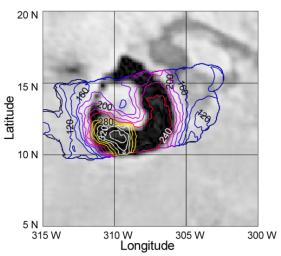Like a terrestrial weather map, this map made by the photopolarimeter-radiometer onboard NASA's Galileo spacecraft shows how temperatures vary across the surface of Jupiter's moon Io. However, in this case the temperatures are due to volcanic activity, not weather. The maps show Io's most powerful volcano, Loki, which was in the throes of one of its periodic bright eruptions when the map was made during Galileo's close flyby of Io on October. The background to the temperature map is a Galileo image of Loki taken earlier in the Galileo mission.
Loki's most prominent feature is the huge horseshoe-shaped dark caldera, 200 kilometers (120 miles) across. These observations reveal that most of the lava lake is at a remarkably uniform temperature, about -23 degrees C (-9 degrees F). This is chilly by Earth standards, but on Io, where most of the surface is colder than -145 degrees C (-230 degrees F), enormous amounts of volcanic heat are required to keep such a large area at this temperature. The uniform temperature, which was also seen by Galileo's Near Infrared Mapping Spectrometer, could be due to a uniformly thick frozen crust over a lake of molten lava, or to a series of old lava flows that have been cooling down for a year or two since they erupted.
The southwestern corner of the caldera is much hotter the highest resolution photopolarimeter-radiometer observation shows peak temperatures of at least 126 degrees C (260 F). It is likely that this is the site of the new eruption that began in September, and that fresh lava erupting there will eventually spill out from this region to warm up the parts of the caldera to the east and north.
The Jet Propulsion Laboratory, Pasadena, CA manages the Galileo mission for NASA's Office of Space Science, Washington, DC. JPL is a division of the California Institute of Technology, Pasadena, CA.
This image and other images and data received from Galileo are posted on the Galileo mission home page at http://solarsystem.nasa.gov/galileo/. Background information and educational context for the images can be found at http://galileo.jpl.nasa.gov/gallery/io.cfm.

 Planetary Data System
Planetary Data System












